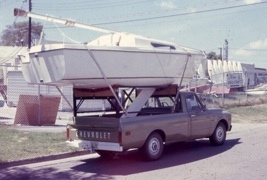Old Sailors Never Die…They Just Get a Little Dinghy
May 31st, 2013 Posted in Conversation, Family | 3 Comments »Old Sailors Never Die…They Just Get a Little Dinghy – that was one of my Dad’s favorites, back when those sayings were popular. He wasn’t really a jokester, but he enjoyed lots of little things, like telling stories and hearing stories told about him – mostly sailing stories. His memory doesn’t help him recall everything lately, but he’s been comfortable and happy.
Sometimes he is concerned because he would like to solve some problem out there, but there isn’t much he can do now. He tries to work out how to find someplace to stay, or how he could make some money. Today he said something about trying to improve the wheelchair. I asked him whether he wasn’t the one who designed the centerboard lift system that the members used at Sequoyah Yacht Club to store their boats above the water (instead of having to pull them out after the weekly races), but he said that he doesn’t remember.
He developed a mast carrier for the Catalina 22, and we used to sell them at Tulsa Sail-Craft. With one device, which had a pair of pintles to hook onto the C-22’s gudgeons, he could not only carry the mast, but could lift the mast high enough that he had a good start on raising it the rest of the way by standing on the cabin. He called it his “six-foot friend.”
He designed some other sailing solutions like a way to determine the depth of the water at the boat ramp, and even submitted some to a national sailing magazine (probably Sailing World), which published at least two. He designed a keel guide for helping to load the retractable-keel Catalina 22s onto their trailers, and he loved to design mast-raising systems for larger boats.
I remember staying up late one night at the old “boat yard,” as he built some sturdy, wooden steps so that potential buyers could step up alongside a soon-to-be-displayed boat on a trailer – probably a Catalina 22. The Boat Show would be the next day and so when it was about time to head for home, he started designing and building those steps. I would probably have been too young to drive, and had tagged along with my dad to work that day. I was an unofficial helper, and he probably asked me to hold this, or hand him that, which I did, and he did the hard part. We were in the very small building which housed the “office” and “shop,” at the boat yard on Latimer Court, behind Burkhart’s Marine. Burkhart’s owners, Art and Ruth Burkhart Obermire, sold marine hardware and rented us the space in the back.
Tulsa Sail-Craft would have two more locations after, and had occupied at least one rental space and our backyard before this one, where my dad sold boats in the early 1970’s. My grandfather (and my sisters probably) helped sometimes, and there were a few paid employees, too. Dwayne Nelson told me that he had worked for TSC when it was on Latimer. We visited after the memorial service for his dad, Charlie Nelson, who had taught our sailing school later.
Actually, I had been on the payroll earlier, as well. My sister and I would assemble the sail rigs for the Dolphins that would arrive at our house by the dozen or so, fastening the sails to the spars, and then the spars to the masts, and adding the main sheet and halyard to each rig and binding the long rig together by a chain of slip knots. The photo that shows a newly-arrived Catalina 22 loaded on the back of a pickup truck, also shows some of the Dolphins leaning against Burkhart’s.
If I ask my dad about all of this tomorrow, though, I’m not sure he’ll feel like discussing it. He was feeling very tired tonight.


